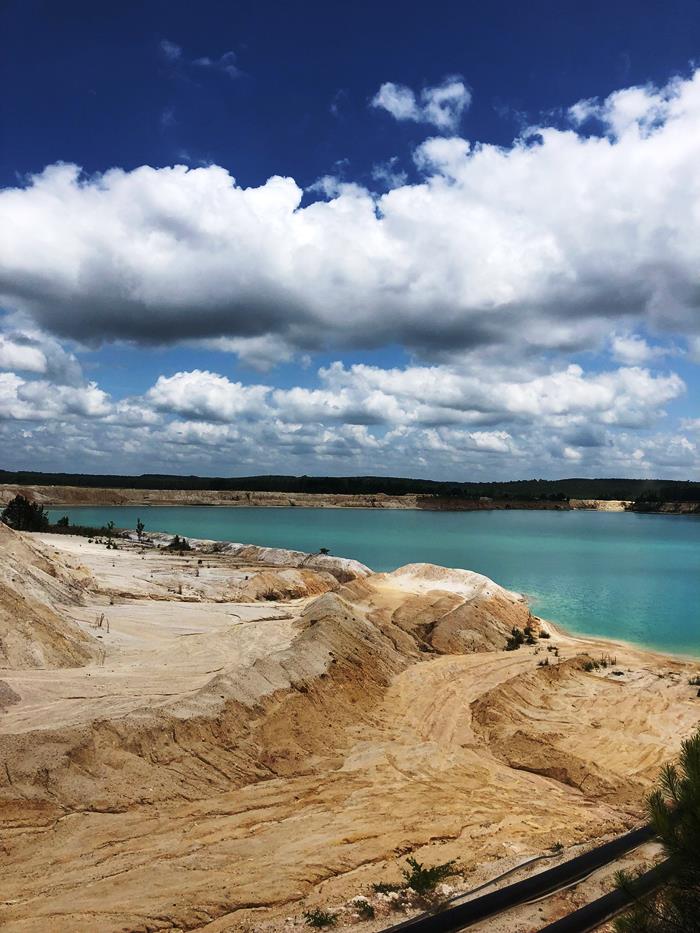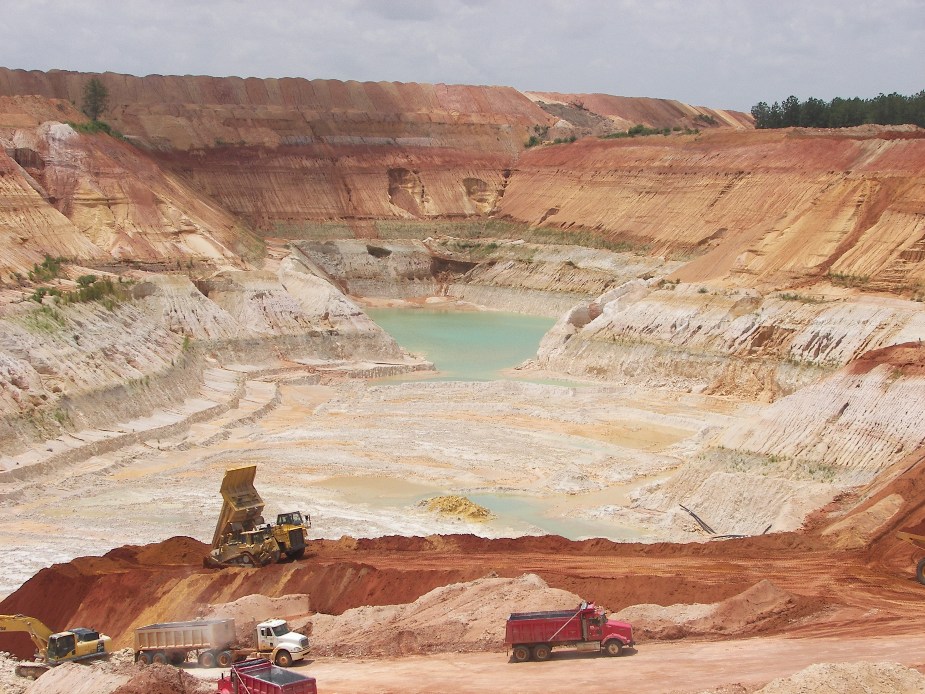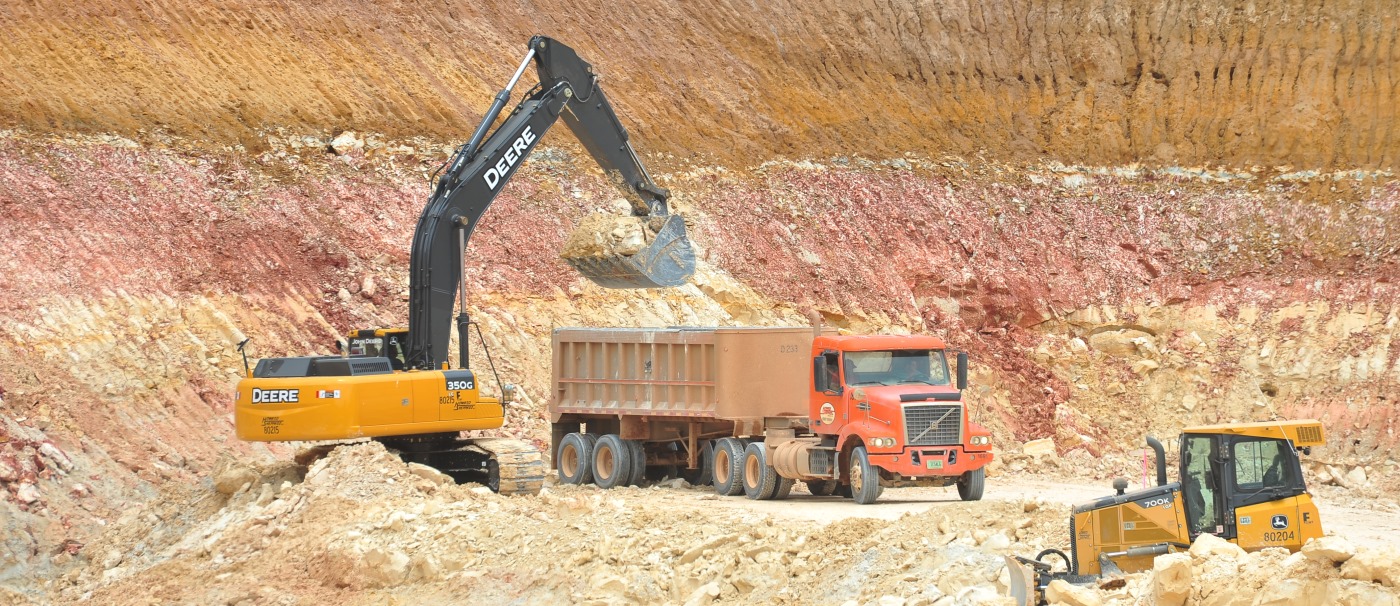Kaolin Capital of the World
Sandersville is known as the “Kaolin Capital of the World.” One of Georgia’s most important minerals, kaolin is a white, alumina-silicate clay used in hundreds of products ranging from paper to cosmetics to the nose cones of rockets.
Kaolin is also used in medicines, paints and many other products, all of which are shipped around the world. At the end of the 20th century, kaolin was an $800 million business and Georgia's largest volume export. Mining companies have reclaimed and restored more than 80 percent of the land that has been stripped since 1969.
About8 million metric tons of kaolin valued at more than $1 billions shipped annually from Georgia with most of it coming from the "white gold" belt in 13 counties along the fall line that girdles the mid-portion of the state.
Mineralogists say that 50 to 100 million years ago, particles of kaolin or aluminum silicate were washed down from the rocky piedmont hills, coming to rest at the edge of a shallow sea, marked today by the fall line. Fragments of fossilized shark's teeth and shells hint at the clay's origin near the shore of the prehistoric sea.
 An annual Kaolin Festival celebrates the importance of the resource. Washington County celebrates it’s heritage as people
An annual Kaolin Festival celebrates the importance of the resource. Washington County celebrates it’s heritage as people
from all parts of the world gather to enjoy arts, crafts, antiques, music, food and a parade.
Founded in 1784, Washington County is one of the oldest Georgia counties. Sandersville was the first U.S. city named for General George Washington, victorious over the British the year before, five years before he became the nation's first president. Two hundred years later, Princess Anne, representing the Queen of England, visited Sandersville as a guest of Anglo-American Clays Corp., a subsidiary of English China Clays, Ltd., a major kaolin mining and processing company in Sandersville. She received a much friendlier reception than the British troops fighting American rebels 200 years earlier.
Even before the Revolution, Georgia clay was being shipped to England. Some of it was carried, probably from near Augusta, down the Savannah River in canoes and shipped from Savannah.
Josiah Wedgwood, famous founder of the Wedgwood Potteries in England, used Georgia white clay in the 18th century, before clay deposits were discovered in Cornwall, England. Georgia's deposits are among the purest and whitest in the world. At first, only small amounts of its kaolin were used, however, and mining it was a small-time activity in a few places. It wasn't until the 20th century that farmers in the kaolin-rich counties began to see the white outcroppings of kaolin as anything but nuisances to tillable farmlands.
Today, workers are busy 24 hours-a-day, trying to meet the world's ravenous appetite for "white gold."
At ultra-modern processing plants, a mixture of water and white clay dug out of the ground is turned into hundreds of products essential to modern life, such as rubber goods, plastics, medicine, toothpaste, insulation, porcelain and paints. But about 70 percent of Georgia's kaolin goes to finish paper. Kaolin, which is about one-third of the total weight of the paper on which this story is printed, makes the sheet white and smooth and enhances the color of the inks.
A tour of the region's open-pit clay mines and kaolin processing plants reveals that a complex, highly sophisticated process is used to turn the white clay into a useable product.
The clay awaits mining in pits where it shows whitely as the red soil is removed from above it. After the clay is dug out of the earth, it is sent up to 16 miles through a pipeline as a slurry, and then pummeled, mixed and purified. The finished product is shipped dry or as a slurry in Sandersville Railroad tank cars that are immaculately clean to prevent bacterial contamination. The whole process is infinitely precise, as skilled workers, technicians and scientists produce kaolin in particles smaller than the size of particles of matter in fog.
The machines that coat paper move at such high speeds that the tiniest impurity, like, a grain of sand, can cause a five-mile streak before the equipment can be stopped. Employees ride herd on this production with computerized and automated rigor to meet the stringent needs of their customers in the paper and other industries.
 Making a Living
Making a Living
In 1911, Washington County's population was more than 28,000 -- its peak. Today it has about 20,000 residents. In 1914, Washington County farmers produced 35,529 bales of cotton and sold it at record prices. But an insect attack and a world war combined to bring the county to its knees. By 1915 the boll weevil began its assault on the area's cotton fields. And with World War I, German submarines sank so many merchant ships that cotton was not shipped, but languished in the warehouses. Cotton prices dropped to five cents a pound. By 1921, the boll weevil cut the county's yield to only 4,452 bales. King Cotton was almost dead.
African-American and white farmers alike abandoned farms and took whatever jobs they could find. This was true to an even greater extent in the nearby counties of Glascock, Hancock, Jefferson and Warren. Grim statistics are the epitaphs of a dying form of agriculture in the region. Shortly after World War 11 there were still 1,776 farms in Washington County and on these farms were 2,464 mules.
"One man claimed he traded two game roosters [for cock-fights] for two mules and got $1.50 to boot, quite a drop in price, considering that before the war, a mule sold for $100," an account in the local Washington County history indicates. But nobody needed mules any more in a day of tractors. In the next few years, even the need for tractors would decline severely. Many fields remained unplowed and farms disappeared. In 1964, Washington County had 731 farms. In 1992's agricultural census only 299 were recorded. Warren County lost nearly three-quarters of its farms in the same period.
Fortunately for Washington County, as the marketplace for some agricultural products declined, the kaolin industry grew. The discovery of the "white gold" of kaolin in the area in the 1920s, and its subsequent development as an industry, offered hope, however. Ben Tarbutton Sr. persuaded major corporations to come to Sandersville to mine the clay, and he extended his Sandersville Railroad, a vital short-line linking Sandersville to the main line at Tennille, to service the clay industry's needs. Many farmers got good money for leasing or selling lands to the kaolin companies.
Under state law, the pits dug to get the clay must be reclaimed, and the companies spend about $1,900 per acre returning mined land back to agricultural, forestry or recreational uses.
(Adapted from the article "Georgia's White Gold, Kaolin" by Al Hester, photos by Laura McNeely)


